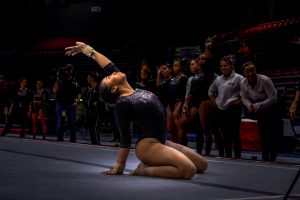Accessible campus always ‘in progress’
October 10, 2006
DeKALB | Entering and exiting a building is simple: you grab the door handle, push or pull, and you’re on your way. But for certain students, this otherwise easy process may be more of a chore than anything.
NIU currently has about 475 students registered with the Center of Access-Ability Resources. The mission of the office, according to its director, Nancy Kasinski, is to assist those in need in the most timely and effective fashion, she said.
Over the last several years, the campus has begun to change in order to better accommodate disabled students.
Academic buildings
Kasinski explained that many changes around the university took place in the late 1990s. Before this, most common academic buildings, such as DuSable, Cole, Watson and Anderson halls weren’t fully up to code. Elevators were added, as well as assisted listening devices for those hard of hearing, visual fire alarms and special desks with removable chairs.
“For the most part, most academic buildings are accessible,” she said. “Now, there are a couple that aren’t fully accessible and probably never will be because of the age of the building. If that occurs then we have to move a class.”
Eric Earhart, a freshman computer science major, has taken notice of the improvements.
“I think what has been done for handicapped students is outstanding, and I can only see things getting better,” he said.
Peter Alfano, a freshman communication major, said he feels some restrictions should be placed on elevators to maximize their effectiveness.
“I personally believe that the school could have rules on elevator usage in school buildings,” Alfano said. “Students with no disabilities do not need to be using the elevators. They should only be for students who cannot get up those stairs.”
Residence halls
The residence halls as a whole are less accessible than their academic counterparts. Currently, Stevenson is the only fully-accessible residence hall on campus, while Grant is scheduled to undergo similar upgrades in the near future. Douglas and Lincoln Halls may not share similar fates.
“The amount of money to make Lincoln and Douglas accessible is going to be humongous,” Kasinski said. “When we deal with housing, it’s another issue because when those buildings were built it was not necessary to have that accessibility; nobody was thinking about it. It wasn’t code; it’s not the fault of Northern, it’s just that’s the way it was back then.”
Lincoln Hall opened in 1962 with Douglas Hall following the year after. Grant Towers opened in 1966 and was followed by Stevenson Towers shortly thereafter.
“Easy fixes were done long ago,” Kasinski said. “If they’re not fixed yet, they’re definitely not an easy fix.”
Though much has been done in the way of making the campus more accessible to students, some obstacles still remain. Bicycles recently have been found locked to wheelchair-accessible ramps outside numerous academic buildings on campus.
“By [locking your bike to a ramp way] you’re blocking access and you might not even know that you’re doing it,” Kasinski said. “They [students] are not even cognizant of what they’re doing.”
Derek Walker is a Web Reporter for the Northern Star.






